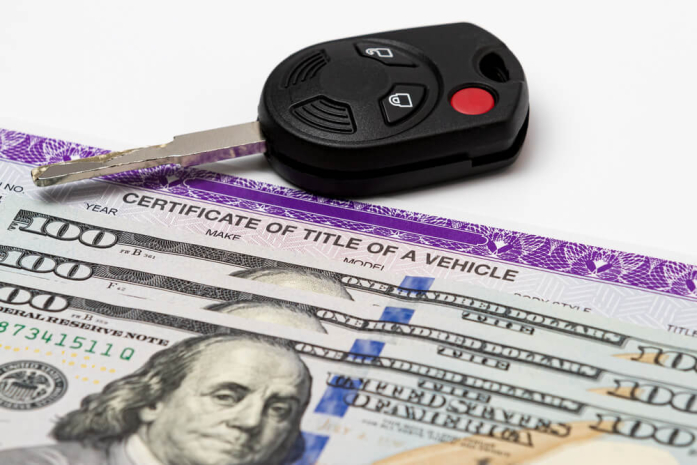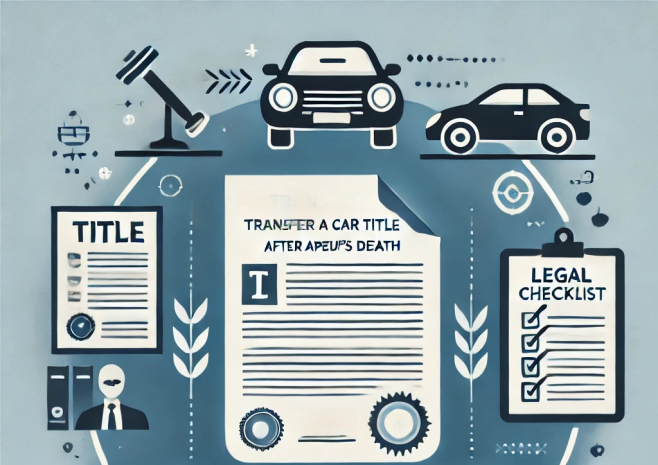When it comes to buying, selling, or owning a car, few documents are as important as the vehicle title. This seemingly simple piece of paperwork is the key to establishing legal ownership, protecting yourself during transactions, and ensuring a car’s history is transparent. Whether you’re purchasing a brand-new vehicle, transferring ownership of a used one, or navigating the complexities of a branded title, understanding how auto titles work is essential.
In this guide, we’ll explore everything you need to know about car ownership certificates — from their purpose and types to common issues and how to resolve them.
What Is a Car Title?
A car title, also called a pink slip, serves as your vehicle's official ID card issued by your state's Department of Motor Vehicles (DMV). This is a document that names the legal owner of a car and provides important details about it. Without an ownership certificate, you can’t legally claim a vehicle is yours, even if you paid for it and have the keys in your hand.
Information Included in a Car Title
Here are some of the main details your car title includes:
- Vehicle identification number (VIN): A 17-character code you’ll only find in your car and in no other vehicle. It allows for identifying your auto and checking its history;
- Make, model, and year: The basics about your car that let everyone know exactly which vehicle the ownership document is related to;
- Odometer reading: The number of miles on the car at the moment of signing the sales agreement. It’s critical to note this for the sake of fairness and to inform future buyers how used the automobile is;
- Car owner information: Your full legal name and address as the vehicle's owner. This will also include the lender’s information in case you’re still paying for the car.
Types of Car Titles
There are different types of car titles. Some relate to a vehicle in good condition, while others may be shaded with past harm. Let’s find out these so that you can safeguard yourself and your money anytime you decide to purchase or sell an auto.
Clear Title
A clear title indicates that a vehicle has no outstanding liens or financial claims against it. It shows that the owner has full ownership rights, ensuring no third parties, like lenders, can claim the auto.
Lien Title
This shows that a financial institution or lender has a legal claim to your vehicle as collateral for a loan. While you are the registered owner, the lienholder has a right to repossess the car if payments are not made. Once you make a final payment, you'll get a title in your name.
Salvage Title
It goes without saying that this is the most “proceed with caution” ownership certificate for a car in the context of its history. Salvage titles mean the auto has been written off as a result of an accident, vandalism, or theft case.
These types of vehicles, however, have the advantage: you can buy them at a very low cost. Yet, it’s a risky business since they often come with many problems and can also be hard to sell. Plus, your insurance company may be hesitant to cover an automobile with such a title.
Rebuilt/Reconstructed Title
These cars were once salvaged but have been repaired and passed state inspection. While they might work fine now, they'll always be worth less than vehicles with clean titles. Smart buyers always get these autos carefully inspected before purchase.
Junk Title
This is the case when a car on the road gets damaged to such an extent that it can only serve as spare parts or scrap metal. Such an auto can’t be repaired or registered for use on the roads; it’s strictly for salvage yards. Or you can always opt for junk car removal services like JunkCarsUs and even get a top dollar for your non-running vehicle.
Lemon Law Title
Defective vehicles are known as lemons, and you don’t want to own one. These are automobiles with serious and irreparable issues. This title warns future buyers that the car had major issues right from the factory that couldn't be fixed after multiple attempts.
Flood Damage Title
Cars and water are a terrible combination. This title means the vehicle has been damaged by flooding, which can cause serious electrical problems and rust issues that might not show up right away. These autos often look fine on the surface but can have hidden problems that appear months or years later.
Hail Damage Title
This title suggests that a car got damaged because of hail storms. While this might just mean some dents and dings on the outside, severe hail damage can significantly affect a vehicle's value. However, these autos are often mechanically sound despite their dimpled appearance.
Bonded Title
A bonded title comes into play in tricky situations where you have a car but can't get a regular title. For example, it could be missed by a previous registered owner or lost. You buy a surety bond as insurance, promising the paperwork is legitimate.
Export Title
This ownership document shows a car is leaving the country and is required when you're shipping an auto overseas. These titles help track vehicles that move between countries and ensure they meet different nations' requirements.
What Does a Vehicle Title Look Like?
Vehicle Title vs. Car Registration
Some drivers may mix up the title and registration of the car. While the former shows who actually owns the auto, it’s the latter that lets you use a vehicle on public roads.
You typically receive the ownership document once at the time of purchase of the car unless you sell or transfer it. In contrast, to keep your registration going, you need to pay some fees to your state, which goes toward road maintenance and other transport services.
How to Obtain a Car Title
Your state's DMV has systems in place to help you get the title you need. Every situation has a procedure, and we’ll describe them all below.
New Autos
This is the easiest way to get an ownership certificate since the dealer handles most of the paperwork (car dealership fees cover this). They'll submit everything to your local Department of Motor Vehicles, and you'll get your new title from the DMV in the mail.
Used Cars
Purchasing a used car from a private person takes a bit more effort. You’ll have to ensure the title held by the seller is indeed authentic and that there are no outstanding liens on it. Both a new owner and seller should sign the automobile ownership document and forward it to the DMV, along with a bill of sale (it’s necessary to calculate sales taxes). Each state has specific requirements for title transfers.
Inherited Vehicles
Inheriting a vehicle upon the death of a close relative also comes with certain steps. You’ll have to present paperwork indicating that, as an heir of the deceased person, you’re entitled to that auto. The process varies by state, so heirs should consult their local DMV for specific requirements.
Gifted Autos
Getting a vehicle as a gift is exciting, but you'll still need to handle the title transfer. The process is similar to buying a used car, but many states offer gift exemptions that can save you money on taxes. You'll need to show that it's a genuine present and sometimes do a bit of extra paperwork to take advantage of those exemptions.
Vehicles Purchased Out of State
Purchasing a motor vehicle out of state is a bit different. First, you have to comply with the laws of both states and obtain a new auto inspection certificate. Also, since there are emissions and safety requirements in some states, make sure you find out about them before you drive your new car home.
How to Transfer a Car Title
Every year, millions of people successfully transfer car titles, so this procedure shouldn’t pose any problems. While the exact process varies by state, the basic idea remains the same: accurately documenting the change in ownership to legally protect both the buyer and seller.
Steps for Transferring Ownership
Here’s how to transfer ownership:
- Sign the title;
- Record the sale price and date;
- Fill in the odometer reading (your current mileage) if your vehicle is under 10 years old;
- Have the seller’s and buyer’s signatures notarized;
- Make copies of all completed paperwork so both parties have them;
- Take everything to the DMV.
One mistake could mean starting over, so take your time with each step.
Required Documentation
Beyond the title itself, you'll need a bill of sale, both parties' IDs, a copy of the new owner’s driving license, and proof of insurance from the buyer. If there's a car loan involved, you'll also need paperwork from the bank showing it's paid off.
Fees and Processing Times
A title transfer fee is determined by the state and can vary significantly, also depending on whether it’s a gift or inheritance. The range is $4 and $164. As for timing, you could get your new title in as little as a few days in some states, while others might take a few weeks.
Replacement of a Lost or Damaged Car Title
Re-applying for a car ownership document because you misplaced it or it has been damaged is easy as well. Just ensure you’ve gathered all the needed documents.
How to Apply for a Duplicate Title
You should start with a trip to your local DMV or their website. Fill out a duplicate title application — each state has its own form, but they all typically ask for basically the same information about you and your vehicle. If the car isn’t yet paid off, you’ll work with the lender, as they would own the title.
Required Documentation
You'll need to prove you're really you and the car is really yours. This usually means bringing your driver's license, current registration, and proof of auto insurance. The good news is that you won't have to remember every detail about your automobile since your vehicle's history is available in the DMV database.
Processing Time and Fees
Most states charge between $10 and $50 for a duplicate title, though prices can vary. Expect to wait anywhere from a few days to a few weeks to get your new title in the mail.
Common Issues and Precautions
Nobody wants surprises when it comes to vehicle titles, but problems can pop up even when you're being careful. Some issues can be as minor as spelling errors, while others might involve fraud, and either case can make buying a car much more frustrating than it needs to be.
Thankfully, though, most problems are avoidable if you know what to watch for, and even if something does go wrong, there's usually a solution.
Errors in the Title
Even small mistakes matter when it comes to titles. A misspelled name, wrong VIN number, or incorrect mileage can cause big problems. To fix them, you have to file paperwork with the DMV, but it's better than having problems later.
Title Jumping and How to Avoid It
Title jumping is when a person purchases an auto and sells it before transferring the vehicle ownership to their name. So, they're "jumping" over their name to save on taxes and fees.
This is a technique used by unscrupulous private sellers and it can create legal problems for you. When purchasing an automobile, always ensure that the dealer selling you the car is the part whose name is mentioned on the title.
Title Fraud and Scams
Some people get creative when it comes to ownership document scams. They might do title washing, forge signatures, or even sell you a vehicle they don't really own. Be careful about sellers who are pushy or titles that look strange. And always check the VIN number against the ownership certificate, look up the car's history, and just trust your gut.
Frequently Asked Questions About Car Titles
How do I read a car title?
The most important parts you should check when reading a car title are title status (usually at the top), owner's name (make sure it matches the seller's ID), VIN number, odometer reading, and signatures.
What is the vehicle identification number (VIN)?
VIN is a 17-character code with numbers and letters that identifies your vehicle. Every other car doesn’t share the same code, and this makes the VIN unique.
What if the title is not in the seller's name?
If someone's trying to sell you a car, but the ownership document's in someone else's name, it’s likely an illegal practice called title jumping. Just because they say, “I’m selling it on behalf of my friend,” doesn’t mean you should trust them. The seller needs to get the title in their name first. No exceptions unless you want a legal headache later.
How do I check the status of a car title?
You can often check a vehicle’s title status through your state’s DMV website using the VIN. To go into greater detail and make sure your potential car wasn’t salvaged and isn’t a lemon, services like Carfax or AutoCheck can help you find out the complete information.




